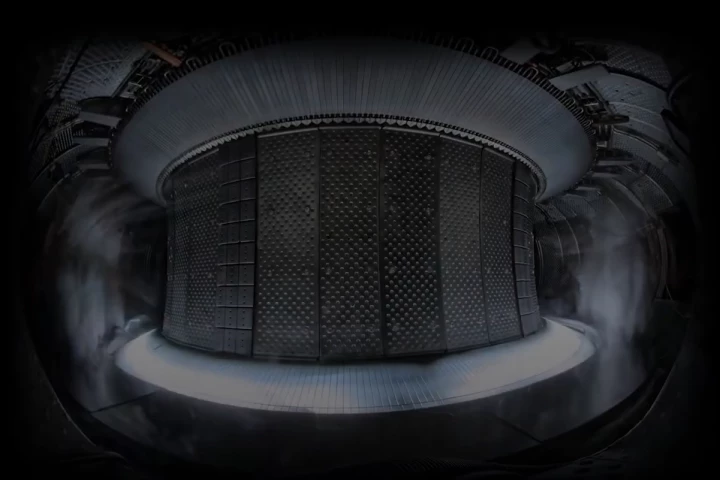Appliance makers have been putting together "Homes of Tomorrow" ever since they realized that electricity was more than a passing fad. Over the decades, Frigidaire, Westinghouse, General Electric and many others have pulled out the crystal ball to gaze into our domestic future. Now GE is jumping forward to the year 2025 to show us what home life will be like in the middle of the next decade.
Back in 1950, GE unveiled its vision of the 21st century kitchen complete with pop-up fridge, ice dispenser, plastic plate maker, and ultrasonic dishwasher. This time around, the company is only hopping forward 12 years and is trying to keep its engineering feet on the ground.
"This isn't about the Jetsons or pie-in-the-sky ideas," says Lou Lenzi, director for GE Appliances’ Industrial Design Operation. "Home 2025 is about reality-based innovation that will be possible over the next decade."

GE says this "reality-based innovation" goes beyond looking at the technological possibilities, but also what would fit the lifestyles of 2025. The designers took into account food science, demographic projections, healthcare, environmental concerns and water scarcity. For good measure, they also made some assumptions about the future economy and commerce.
"To project what the Home of 2025 may look like, we first took a high-level look at where we think society, culture and technology are taking us and intersected that with ways in which we could make our lives less complex and more enjoyable," says Lenzi. "We conceptualized how we will prepare meals, wash clothes and interact with information as families over the next dozen years."

The World of 2025
The world, or the United States, at least, that GE envisions has gone through major demographic shifts and is now heavily influenced by an ascendent Hispanic culture, which GE sees as more leisurely, family oriented and social. In addition, the population is aging with the resulting lack of a labor force to look after them, so they need more means for living independently.According to GE, the society of the future is more urbanized, frugal, and environmentalist. Most people are living in flats or smaller homes with less floor space and less discretionary spending. They’re more likely to lease and to club together for appliances or service plans, prefer local food sources and organic farming, want appliances that use only minimal water, and would rather have sustainable clothing made out of fabrics that use less water for laundry.
GE’s prognostications concentrate mainly on the urban flat dweller, but it has other concepts for those still living in larger condominiums or the suburbs. The GE Home of the Future is, not surprisingly, a smart house, but it’s a bit more realistic in some of its approaches. For instance, there’s very little about the puzzling idea of surfing the internet on your fridge. Instead, the designers postulated that in the next decade countertop appliances will be a thing of the past. Just as cameras, alarm clocks, music players and telephones have vanished into the smartphone, GE believes that appliances will merge into multi-purpose “uber-appliances.”
Smart Faucet

One example of this is a smart faucet that acts a bit like those soda-dispensing pistols found in pubs. A touch of its top screen and it provides filtered or carbonated water. It also makes its own ice by dispensing supercooled water that freezes instantly. Cartridges under the sink make it customizable, so it can dole out vitamin water, and other beverages. For the health conscious, there are sensors that tell you your hydration levels at a touch.
Food Preparation and Storage
Instead of having discrete things like sinks and countertops, the kitchen of 2025 has modular units that combine traditional functions while adding some new technological twists. Fresh food, for example, is kept in a ventilated drawer close at hand. The sink isn’t just a place to wash veggies. It can also detect and measure bacteria and chemical levels and let you know when you’ve washed them all away. In addition, the sink is a mini dishwasher that can handle a small load in five minutes and washes the cutting surface at the same time, which acts as its lid. Underneath is a larger washer for bigger loads. The pre-rinse water for the dishwasher is heated by waste heat from the fresh food drawer that uses an evaporation cooler to keep it at just the right temperature and humidity.
Instead of a disposal, there's a food compactor, which squeezes scraps into compost pellets, which you can stick into the automatically watered herb garden that lines the back of the unit. This is watered with grey water from the dishwasher.
GE’s main point in all this is to imagine squeezing as much as possible into a unit only 27-in (68-cm) wide. An even more extreme example is the all-in-one fridge. Where the present day fridge is a cabinet with one section set to “cold” and the other to “freezing,” the fridge of 2025 is a unified storage system that monitors home inventory and searches markets in the area for info on food and local farmers.

The fridge is modular, consisting of cylindrical containers that fit into holes. Each container has its own refrigeration unit and the modular design means that it can be adapted to larger items, so you store a chicken and not live on salami. Outside your flat is a similar module unit that allows deliveries to be stored for pickup. The unit powers the modules, keeping the contents hot or cold.
A larger version of the fridge abandons the modular design in favor of one where each shelf is sealed off from the other and individually temperature controlled, so the fridge is actually a general storage cupboard for all foods, not just those needing to be kept cold or frozen. The height of the shelves is controlled magnetically and can be changed at the press of a button without removing and reinserting them. The outside of the unit displays the contents of each shelf, as well as other information, such as quantities and expiration dates.

Cooking
The cooker, for want of a more precise term, is really a system that by 2025 will do for countertop appliances what the smartphone did for stereos, calculators, cameras and small televisions. Instead of counters covered with blenders, coffee makers, and toasters, 2025 will see these appliances either supplanted by multi-function devices or converted into modular units that are either incorporated into or stow inside the kitchen system.
Auto-Burner

One example of this is the Auto-Burner, which is an induction heating surface that is under the top pattern of the counter, yet appears wherever you place the pan and fits up to five cooking zones. Along with this comes a set of standard-sized induction accessories, such as a griddle, wok, grill, steamer and panini press that stow away in their own special drawer.
Urban Grilling

Even though GE sees most people living in small flats, that doesn’t mean that the barbeque will die out. For urban grilling there’s an electric grill that is window-mounted and compact with powerful fans to draw off fumes.
The Hub

Where space is available, the more compact cooker of 2025 gives way to the Hub. This is an island kitchen reimagined as a social gathering place. Complete with voice, motion, and facial recognition, it has a ceramic glass surface, which acts as a large, remarkably flexible, induction cooking surface that can accommodate multiple cooks. It also has multiple cameras and projectors for sharing online cooking and displaying a virtual chef, which is projected on the cooking surfaces.The idea of the Hub is to make cooking less of an everyday chore and more of a recreational, social experience. The Hub allows the user to play games in a virtual kitchen that automatically incorporates your GE appliances into its software as they're installed. The Hub lets you share cooking in real time with others, take step-by step-lessons from virtual experts, earn rewards, compete socially, and generally make cooking communal. The visual aids move aside to make room for the pans and can even generate a simulated celebrity chef to “make it more of a party than lesson.”
The cookers of 2025 will also have built in sensors, such as a scale, so you can measure ingredients straight into the pan while the cooker tells you when to stop, and the ability to communicate with your smartphone and other devices, so cooking doesn’t mean being tied to the kitchen.
For those who live in houses, 2025 may also see a kitchen that swings out onto the patio for entertaining.
Death of the Supermarket

In 2025, GE sees the supermarket going the way of the video rental or book shop with more and more groceries being ordered online and delivered to the home. Shopping in the next decade will be like buying an ebook or music today. According to GE, it will be done using digital apps, by the kitchen system automatically referring to the household inventory in the same way as a smartphone app updates itself, or even ordered directly from an indicated recipe. This won’t be just the case with food, but also medicines with the info shared with the family as needed.Deliveries will be less like FedEx and more like a high-tech version of the milkman. For the flat dweller, groceries will be delivered in glass modules set in a special powered rack outside the door. For houses, deliveries are deposited in a locker on the outside of kitchen wall. The locker door and guiding lights indicates what package is to placed on which shelf. As they are deposited, a conveyor system identifies the packages using an RFID tag and moves them into a compact stack, much like a vending machine. The machine can also prepare meals and dispense them while updating the inventory.
Watering the Garden

With a population more interested in environmentalism and sustainability, GE sees urban gardening taking off with herb gardens and portable “garden walls” as a way to have fresh greens always available. However, by 2025, GE sees these as being more than mere planters. These will be designed to clean the air, act as sound barriers and recycle grey water from the dishwasher using pumps powered by photovoltaic cells.The garden wall will also be portable and have embedded sensors to let you know when plants need tending or are ready for harvesting. This sensor arrangement is shared by urban gardens in larger dwellings, which either have a large patio garden that looks a bit like a solar-powered salad bar, or vegetable beds where marble-sized portable sensors send reports to your smartphone.
GE also sees the urban garden hosting a beehive to pollinate the flowers and provide honey. Being a very civilized urban hive, it senses when you're in the garden and emits a harmless smoke that calms the bees into leaving you alone.
Laundry: 2025

According to GE, the home of 2025 won’t have the usual washer/dryer combo. That’s not surprising, but what is is that it won’t have things like cupboards or dressers either. Instead, the washing machine acts as a combination washing, drying and storage unit. The clothes have RFID tags that tell the machine how to sort the laundry, what temperature, and which cycles to choose. After clothes are cleaned, they're compressed into "pellets," inventoried and stored in the machine. When it's time to dress, the machine tells you what is available and makes suggestions based on the time of year, weather, and what goes with which outfit. The machine then revives the clothes using steam and dispenses them. The pellets can also just be unpacked and shaken out.
The pellets are so compressed that a complete change of clothes could be carried in a purse or briefcase, putting the future of the humble gym bag under a cloud. GE envisions health clubs, airports and other public places having machines for reviving and compressing clothes.
GE also sees clothing stores being much smaller with only sample garments on display and the purchases items taken away in pellet form.
Helping the Elderly

Because of an aging population, GE sees home technology becoming more intuitive and designed to help people who are not comfortable with technology to continue to live independent lives. Something as simple as a nightstand in 2025 will have a heat-sensitive top that can be used to leave messages or can sense the temperature of what is placed on it and keeps it hot or cold using a thermo nano material. A small comfort perhaps, but a hot cup of tea in the morning becomes more attractive as the joints stiffen.
Medical Dispenser

There’s no need to remember what medications to take when living in GE's Home 2025. Just place your hand on the mirror, and the Medical Dispenser reads your vital signs and decides the amount of medication needed for the day. The machine combines, processes and dispenses the medication in liquid form. Medication cartridges can be easily reloaded.
Fresh and Serve

Another aid to the elderly is the Fresh and Serve, which can keep pre-made meals at the proper temperature and humidity for up to eight hours, making it easy for caregivers to make sure that their charges have a decent meal. GE imagines that the Fresh and Serve would not only heat the meal, but tell you when the food is ready on either a display screen or using an app.
3D Printing

Today, 3D printing is exciting engineers and hobbyists and GE sees it as becoming part of household life in 2025. The company feels that it makes it easier to live in smaller spaces because things don't need to be stored against future use. Rather than taking up valuable space, printing spare parts, electrical components, decorations, and even making the dog a chew toy will be commonplace. Surplus or broken items can be ground up and the material reused, and GE even sees edible printing and clothes printing. Both are possible, but GE sees this use as still confined to the decorative or novelty in 2025.The video below introduces the Home of the Future project.
Source: GE














































